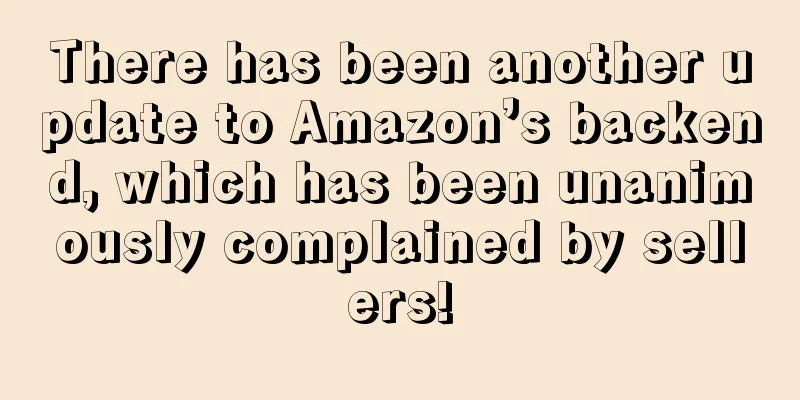Profits dropped to zero, Amazon sellers were forced to quit

|
Why waste time on Amazon if there is no profit?
The internal competition among Amazon sellers has entered a white-hot stage. "Philanthropists" in multiple categories have frequently appeared, and the top sellers have joined the internal competition, repeatedly lowering product prices. In the end, many sellers' profits fell to zero or negative, and they had to clear their positions and leave the market.
However, despite the intensified competition, the profits of products in categories such as health and beauty, electronic products, toys and games are still as high as over 20%, and some categories still have certain opportunities.
Profits dropped from 30% to 0, and sellers had no choice but to enter the low-price circle
Recently, many sellers reported that Juanwang kept entering new categories, and the product profits kept falling, eventually falling to 0 yuan. The head pulled down the price of old links, and sellers had no choice but to enter the low-price circle.
Seller A introduced that the new product was launched in April, originally priced at 25.99, with a profit of 30%, and sold 7-10 orders a day. After one month of sales, it was out of stock, and the factory delayed for half a month to restock. After the goods arrived, it was found that it was extremely difficult to push them again. On the one hand, the ranking dropped, and on the other hand, many low-priced competitors appeared in the market.
A competitor has a big seller who sells many similar products in a month, with a price 2 dollars lower. Soon, the sales volume reaches dozens of orders a day. He and other sellers insist on selling at 25.99, but the big seller reduces the price by one dollar every once in a while. Seeing that the competitors have been reducing prices, A and several other sellers are also anxious and reduce prices one after another. The product price is reduced to 23.99, 21.99, 20.99, and now directly to 18.99. In just 2 months, the profit has dropped from 30% to 0, and there are thousands of stocks to be digested.
“I really don’t understand why everyone insists on having low-price coupons when the profit is the same for the same order volume, and why they also put up a lot of homogeneous products!” A sighed helplessly.
The king of volume entered the market, and the sellers were swept forward. Seller B encountered a similar situation. The product price was 25.99 at the beginning, with a profit of more than 30%. After it was out of stock, he airlifted it to replenish the stock. He found that his peers began to roll in, and the lowest price dropped to 13.99. He was losing money but making a profit. B lowered the price to 22.99 and invested a lot of advertising. As a result, the advertising bidding was high and the conversion rate was not good. He could only follow the price reduction. He sold for more than half a year but the inventory was not cleared. Finally, the product was abandoned.
Seller C said that when the product was launched, there were only three or five sellers, all selling it for more than 25.99. Two months later, at least 20 to 30 sellers entered the market, and everyone was frantically cutting prices, offering discounts, and various other discounts. Now, even at 16.99, no orders are being placed, and a $3 coupon is required to place an order. He is preparing to sell out at a loss.
Many sellers are caught in a price war with competitors, and their profits are constantly being pulled down. One seller made three products, and after the price cuts by his peers, he could only sell them at low prices to clear his inventory. Nowadays, it is very risky for Amazon sellers to launch new products. The first consideration is whether they can bear the losses. Remember not to assume that sales, advertising budgets, profits and other unstable factors are based on previous performance.
Not only new products, but also old products are experiencing the curse. One seller said that the highest market price of an auto parts product during the peak season was between $200 and $300. Factory sellers entered the market and started a crazy internal competition mode, which pushed the product price to $49. Excluding the first-leg freight and platform commission, the product basically has no profit. There are also many products sold at prices 50% and 80% lower than the market price, causing other products to completely lose the initiative.
An old link of another seller has not performed well since April. It is useless to supplement with off-site coupons. This year, there is another "God of Coupons"-level seller in the category, and its ranking has surged. The seller insisted on not lowering the price for a while, and the sales and ranking plummeted. Finally, he chose to lower the price after the membership day . After the price reduction, the traffic, conversion, ranking, and order volume are stable, but it has entered the low-price circle, and it is difficult to raise the price back.
The real feeling of many sellers is: many categories are now caught in the vortex of low prices, with no profit at all. They don’t know whether to continue doing it. It seems that the top sellers want to squeeze all their peers to death and monopolize the market.
Industry insiders bluntly stated that for popular products, market prices generally continue to decline, especially in today's situation of intensified internal competition, where you either get swept away by others or sweep others away.
With a net profit of more than 21%, sellers in 20 categories are the most profitable
Due to factors such as intensified competition, price wars, and increased advertising costs, many categories are no longer profitable, and subcategories are also in danger. However, there are still categories that perform well, or in other words, there are profitable sellers in every category.
JungleScout conducted a survey of more than 21,000 sellers and found that 2% of home and kitchen sellers have a net profit of 51%-100%; 10% of arts, crafts and sewing sellers also have a net profit of 51%-100%. In addition, the proportion of sellers with a net profit of more than 21% is as follows:
1. Beauty and Personal Care: 30% of sellers 2. Home and kitchen: 30% of sellers 3. Clothing, shoes and jewelry: 27% of sellers 4. Arts, crafts and sewing: 23% of sellers 5. Electronics: 22% of sellers 6. Sports and Outdoors: 21% of sellers 7. Health, Home and Baby Care: 21% of sellers 8. Toys and Games: 20% of sellers 9. Groceries and gourmet food: 19% of sellers 10. Mobile phones and accessories: 17% of sellers 11. Electrical appliances: 17% of sellers 12. Office products: 17% of sellers 13. Babies: 16% of sellers 14. Pet supplies: 16% of sellers 15. Books: 15% of sellers 16. Tools and Home Improvement: 15% of sellers 17. Auto parts: 13% of sellers 18. Garden and Outdoor: 13% of sellers 19. Handmade: 11% of sellers 20. Collectibles and Art: 10% of sellers
Outside of these more profitable categories, there are profitable sellers in every category on Amazon, but there are also a much larger number of sellers with lower or no profits. Of all those surveyed, 8% of sellers are not profitable.
These sellers also selected the top 10 popular categories, namely: home and kitchen, beauty and personal auto, clothing, shoes and jewelry, toys and games, health home and baby care, babies, electronics, sports and outdoors, pet supplies, and office supplies.
The 10 least popular categories are: appliances, garden and outdoors, mobile phones and accessories, apps and games, automobiles, handmade, computers, industrial and scientific, collectibles and fine art, CDs and vinyl records, luggage and travel equipment, video games, and musical instruments.
It is worth noting that not all popular categories are profitable. For example, in the top-ranked home and kitchen category, 14% of sellers are not profitable. Among unpopular categories, 42% of car sellers have a profit of more than 21%.
The seller's profit does not depend on the popularity of the category, but on the competitiveness of the selected products, prices, commodity costs and other factors. In the final analysis, the most important factor in whether a seller is profitable lies in the product, which may be what the sellers in the industry mentioned that the product is king. For more sellers, the core of product selection is always demand, which is more important than the category.
When products are highly homogenized and profits are being eroded, Amazon sellers compete on uniqueness and who can survive in the end. In this process, some people lose money in the competition and eventually gain a front-row position, while a large number of people lose money and leave the market, completing the mission of being leeks. Amazon Seller profit |
>>: Top selling pictures suspected to be stolen! Arrow pointed at Temu sellers
Recommend
AliExpress Russia launches new feature that allows buyers to merge sellers’ orders
AliExpress Russia has launched a new feature that...
New Jersey will enact new laws to fine e-commerce companies for excessive packaging
Here's what happened: New Jersey Congressman ...
Ocado leads online grocery market with sales of £599m
It is reported that British online grocery retail...
Blind boxes? Auctions? What happens to unclaimed packages?
I wonder if you have ever thought about this ques...
What is Steampunk Archipelago? Steampunk Archipelago Review, Features
Steampunk Archipelago is an independent website d...
What is PickFu? PickFu Review, Features
PickFu is a platform for obtaining consumer feedba...
Despite closing thousands of stores, the net profit surged by 400 million yuan. What did Suntech do right?
As we all know, traffic is a very important facto...
What is Shopping Feed? Shopping Feed Review, Features
<span data-docs-delta="[[20,{"gallery"...
How to choose holiday products: Etsy releases annual holiday trend report
Etsy has released its 2021 Holiday Trends Report ...
What is Qifeng? Qifeng Review, Features
Shenzhen Qifeng Supply Chain Service Co., Ltd. fo...
Black History Month is here, and here comes a marketing opportunity for sellers!
Speaking of February, sellers may first think of ...
"Cross-border fertile soil" +1! Selling 27 million US dollars during Black Friday alone
Technology and intelligence have spread to every ...
What is Sina Pay? Sina Pay Review, Features
Sina Payment Technology Co., Ltd. is a profession...
Cross-Border Link predicted a loss of 3.8 billion last year, and two directors of the company have resigned!
There have been many major events in the cross-bo...
What is Shoplus? Shoplus Review, Features
Shoplus is a business brand under Zhizhen Technolo...









